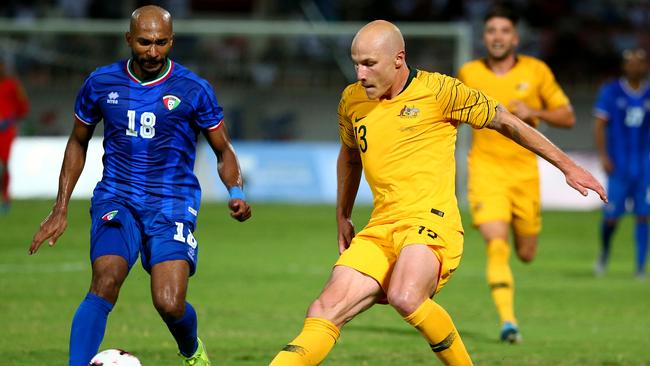Revealed: How Socceroos built on Olympic science to beat heat in World Cup qualifier in Kuwait
The Socceroos played in 38C heat against Kuwait and will potentially face further extreme conditions in World Cup qualifying, but thanks to sport science they are well prepared.

Football
Don't miss out on the headlines from Football. Followed categories will be added to My News.
Socceroos staff have built a scientific model to beat the heat in World Cup qualifiers, with players spending hours in saunas and wearing multiple layers in training sessions at their clubs to prepare for temperatures close to 40C.
Based on the heat acclimation program developed for athletes at the Tokyo Olympics by scientists at the AIS, the model was used with immediate effect in this week’s 3-0 win away to Kuwait in which the temperature was 38C at kick-off.
Coupled with “pre-cooling” techniques before the game to reduce the likelihood of players’ body temperatures spiking in the heat, the regime will assist in preparing for next month’s trip to Chinese Taipei and potential trips to the Middle East later in the qualifying program.
Stream live coverage of the 2022 FIFA World Cup Qualifiers with Fox Sports on KAYO. Get your 14 day free trial & start streaming instantly >

Socceroos staff were able to draw on research prepared for athletes preparing for the Tokyo Olympics by AIS sports scientists Peta Forsyth and Jo Miller, with players given preparation regimes to follow even while still with their clubs.
Those involved spending defined periods in saunas and hot baths, and “overdressing” at training in specific kit, to get them used to functioning with a higher core temperature.
Then came several days of training in Dubai where the temperatures were slightly lower than Kuwait but the humidity levels were much higher — in effect making the conditions there harder, especially cumulatively, in order for the game conditions to feel relatively easier.
“Knowing the conditions we were going to face, we set a schedule of pre-[FIFA] window heat preparation,” said Andrew Clark, the Socceroos’ head of sports science.

“This gave us a head start on arrival in the UAE. Conditions there were relentless with temperatures at times over 40C with 80 per cent humidity.
“The boys were adapted to the conditions over those five to six days with fluid losses during training of around 3kg even with hydration during the sessions.”
Not even the goalkeepers found the conditions normal, with Sydney FC keeper Andrew Redmayne losing 3.5kg by the time the squad left Dubai.
“We knew when we travelled to Kuwait the temperature would be higher but the humidity less, making cooling the players easier,” said Clark.

With daily temperatures in Kuwait averaging around 45C with humidity at 10-20 per cent, attention turned to “pre-cooling” the players before the game which kicked off at 6.30pm local time.
Forsyth and Miller have researched a variety of ways to chill players before an event, with energy-drink “slush puppies” and ice towels found to be particularly effective in combination.
“We utilised various strategies of ice baths, cold showers, fans, cold fluids and ice towels to minimise increases in body temperature,” said Clark.
MORE NEWS
NRL fan survey: The team fans love to hate
Marsh’s reward for refusing IPL cash
Why the outrage about Harris statue?
“Hydration strategies during the match helped us reduce body weight losses to similar numbers we experienced in training in Dubai.”
Even playing only 69 minutes, Mat Leckie — one of the fittest players in the squad and once recorded as the fastest player in the Bundesliga — lost 2.9kg during the game.
“All those measure definitely helped performance, especially late in the game,” said Clark. “The main effects we see are a reduction in top zone speed and accelerometry data [the speed of players acceleration] as the game progresses that are a consequence of the heat and pitch conditions.”
